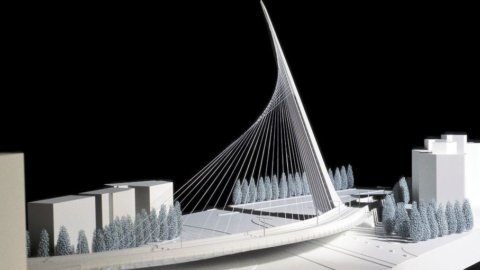On 5 December, in the monumental spaces of the Braccio di Carlo Magno, the exhibition Santiago Calatrava opens to the public. The metamorphoses of space, which will remain open until 20 February 2014. The exhibition, promoted by the Vatican Museums and the Pontifical Council for Culture under the curatorship of Micol Forti (Curator of the Vatican Museums Contemporary Art Collection), offers the public a collection of about 140 works to present the complex and multifaceted artistic production of the famous architect and engineer of Spanish origin. A selected nucleus of architectural models is accompanied not only by the related preparatory studies, but also by watercolor paintings, born from a creative vein completely independent from the genesis of the projects themselves, and by a rich anthology of sculptures, both monumental and of a more reduced, made of bronze, marble, alabaster, wood.
The juxtapositions between works belonging to different, albeit contiguous, artistic codes follow various criteria to direct the observer's gaze towards diversified levels in the reading of architectural volumes, of the vision of space and forms, aspects proper to Calatrava's artistic career.
The large architectural model of the Greek Orthodox Church of St. Nicholas in New York, designed for Ground Zero, is flanked by evocative watercolor drawings in which the artist's gaze ranges from the study of the mosaics and domes of Hagia Sophia in Istanbul to the unfolding of a camellia, from the arch drawn by the weight of a palm leaf to the face of Christ, the ideal model for the church with a central plan.
The splendid twisting of the sails that give life to the project for the Palasport in Rome, for the University of Tor Vergata, is juxtaposed with three beautiful paintings of crouching figures: an almost unexpressed, contained dynamic tension in the study on the balance between forces.
The verticality of the Towers of Malmö or Chicago is reflected in the unstable equilibrium of the sculptures associated with them.
The reflection on the human face finds completeness in the roundness of the marble and alabaster sculptures, in the enclosed form of the Tenerife Opera House, or rather it seems to dissolve in the transparency of the colored surfaces of a series of geometric watercolours.
The movement is real when it opens, like the petals of a flower, the links that make up two twisted bronze columns; when it modifies the chromatic nuances of the Moving Paintings; when he crosses the void in the Buenos Aires Bridge. It is a visionary movement, and no less true for this, in the interweaving of the horns of massed bulls, in the dry branches of a lightless forest or in the bodies, which with their gestures compose physical, psychological and spiritual spaces.
In addition to the new Greek Orthodox Church of St. Nicholas, the splendid model of the bold project for the Cathedral of St. John the Divine, also in New York, is also on display. The magnificence of this extraordinary idea of sacred space that converges with and in nature is counterbalanced by the model of the Los Angeles Chapel, dedicated to Father Junipero, a Franciscan friar who in 1767 was sent to the missions of "Baja California". The hut, the first church erected by the small community, is the model for a chapel immersed in space, water and air: its non-walls open to the outside, rising like the branches of a tree, giving up any physical boundary between the sacred space and the community.
The catalog, for the Edizioni Musei Vaticani, is presented by Antonio Paolucci, Director of the Vatican Museums, with the contributions of Gianfranco Ravasi, President of the Pontifical Council for Culture, Antonella Greco, Full Professor of History of Architecture at the Faculty of Architecture of Rome, La Sapienza, and Micol Forti, curator of the Contemporary Art Collection of the Vatican Museums. Cards by Francesca Boschetti, Micol Forti, Rosalia Pagliarani.





